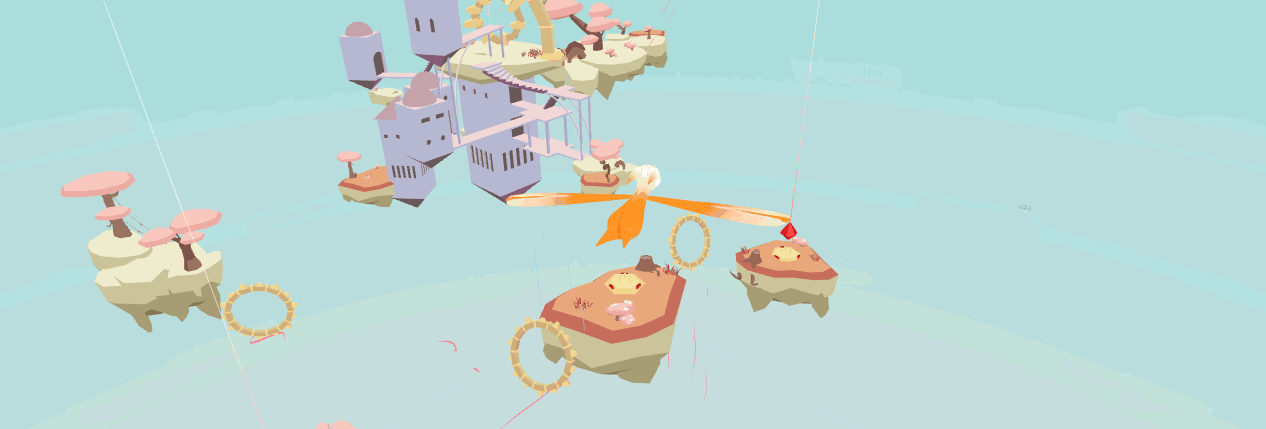

EFIR is a mobile game project, made with a team of 7 students, at Rubika Supinfogame, our game dev school.
It was our first medium-sized mobile game project, thus we learned a bunch of things, especially on Unity.
We worked on it for 3 months, during Spring 2019.
SUMMARY :
Specs : Mobile game / Solo / 3D / Third Person Camera / Accelerometer Controller / Made with Unity Engine
Genre : Contemplative flying game / Puzzle / Adventure
EFIR
Synopsis :
Game Pitch :
▲
▲
Inside far and forgotten skies, lies wind spirits, embodying the Efir : the natural wind energy that controls all the aerial elements there is. [...]
You control the awakened Efir spirit with the phone's accelerometer, by rotating it : Left & right to make the spirit turn, down to make him dive and gain speed, [...]
MY TASKS
Game Design (Lead) - Balancing - Misc. (Integration, LD Tweaks, Shader Tests)
GAME DESIGN
On EFIR, I worked on the choice of every game mechanics in the game, along with helping to set up the aesthetics (game design, narration, graphic universe) of the game, as well as taking part on macro Level Design, ensuring each zone followed our intentions.
When beginning a new project, I like to quickly define the intentions, to make sure everyone have the same idea on what the player' will feel, do, etc.
During the whole production , i've made sure that we all had the same idea of the game we were working on :
A soothing experience. Something calm and peaceful, our goal was to make a fresh air effect.
As it was a limited-time project, on mobile, we wanted to make something simple, despite being in a 3D environment.
Therefore, we needed the screen to be clear and readable : No UI, No constant fingers use.
We opted for a gyroscopic-only controller, with only one different input : when the player touches the screen, they can stop time, and locate themselves.
We were inspired by Jenova Chen's Flow theory while designing the controller.
However, we needed a starting, and ending point for our game, as it was made as a standalone project for school. Therefore, we made up some very simple "puzzle" mechanics, to add to the contemplative gameplay : Pass through a point A, then B, to activate a way towards the C point.
We added to that a bit of backstory, for the character to have a goal.
To make the progression smoother, and ensure the player has fun while going with the flow, we worked on level design blocks :
Having levels with a clear, bigger central spot with the objective on it, so that the player got a good visual mark, to place himself in the 3D environment : feeling lost and confused is one of the worst feels we could want for the player.
Then we thought about wind, to condition the players movement and help him gets to important spots easily, with the pleasure to go fast...
And then we designed the last 'puzzle' mechanics, like the aura, it's visual effect, what does it activates...
GDD REDACTION
As I said before, we
Therefore, I wrote the Game Design Documents,
where I made all of our ideas clear and permanent.
I used Google Suite, to interconnect the Sheets documents with the
Google Docs ones : On our asset list, if someone of the team wanted to know what was the purpose of some asset, he just had to click on it to open the GDD, with the asset named, and a detailed description of its appearance, and purpose. This was done so that the Game Artists could have everything they needed to know about the GD, when they wanted.
But I also wrote a quick, basic but efficient lore to the game : Even if our game have only a few words in it, having a narrative basis was important to us to stay coherent, especially again for the Game Artists. Setting up a small universe, with key features, in terms of graphics and history, helped us having new ideas about the different levels, and what'll they represent.
The team was composed of 4 Game Design & Management section students, and 3 Game Art section students :
GAME DESIGN :
• Alexis Jouanneau
• Corentin Castric
• Louis Houyez
• ...And me
GAME ART :
• Hugo Bonte
• André Rizkallah
• Céleste Ébran
3C BALANCING
We got a whole bunch of variables in the game : speed, acceleration (with their changes when we have different movements) , angles, effects duration... Everything that needs to be done for the game to feel good, or at least a little less uncanny.
The main part of my work on the engine was on the controller & camera. As the game's alot based on the pleasure of flying, the controller needed to be smooth and good, and the camera to keep the environment visible with elegant moves.
Here, the term 'Balancing' isnt only on theoric purposes, I spent a lot of time iterating with different animation curves, coding long lines just to calculate the interpolation of the camera between positions, and doing multiple tests to have a good camera, along with the diverses floats needed to have a functioning controller. I had to work close to the Game Artists again to ensure the graphics were well rendered, going with the game's flow and intentions.
I know it's not related, but I also worked on a custom shader to create a fake blur effect, to enhance the game feel.




Using headlines, bookmarks and hyperlinks, I helped the game artists and game programmers to seek the exact informations they needed, without having to search for it. I also tried to make my own macros.